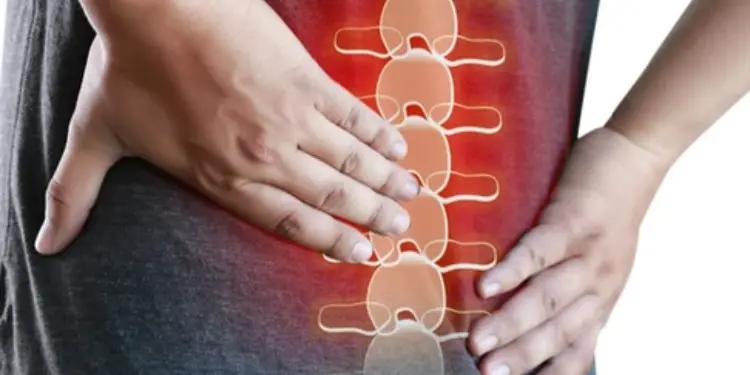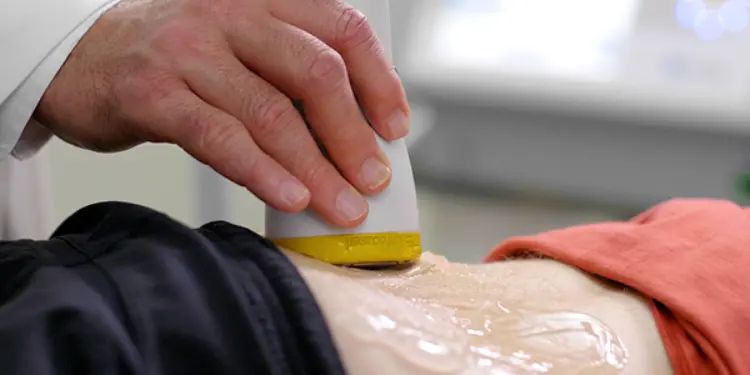Unveiling the secret weapon against lower back pain: Ultrasound therapy. Discover how this innovative treatment is revolutionizing pain management for countless individuals battling with discomfort and limited mobility. Imagine a non-invasive, drug-free solution that targets the root cause of your lower back pain, offering relief and promoting healing from within.
In a world where chronic pain can disrupt your daily life, ultrasound therapy emerges as a gentle yet effective solution to help you reclaim comfort and mobility. By harnessing the therapeutic properties of sound waves, this cutting-edge technology penetrates deep into the tissues, soothing inflammation and enhancing circulation to accelerate recovery.
Say goodbye to conventional treatments laden with side effects and hello to a safe, effective alternative that prioritizes your well-being. Join us as we explore into the transformative impact of ultrasound therapy on lower back pain and unlock the path to a more comfortable and active lifestyle.
Understanding Lower Back Pain
If you’ve ever dealt with lower back pain, you’re not alone—it’s a common issue that affects millions. It can happen for many reasons, like muscle strain, ligament sprains, herniated discs, or degenerative disc disease. A sedentary lifestyle, poor posture, or injuries from daily activities can all contribute. Since back pain can range from a sudden, sharp twinge to a dull, lasting ache, understanding what’s causing it is the first step toward finding relief.

The impact of lower back pain can be profound, often extending beyond physical discomfort. Many individuals experience limitations in daily activities, impacting their work, social interactions, and overall quality of life. The interplay between physical, emotional, and psychological factors can exacerbate feelings of distress, leading to increased anxiety and depression. Recognizing this multifaceted nature of lower back pain is essential for devising comprehensive treatment plans that address not just the symptoms but also the root causes.
Moreover, lower back pain can be classified into two main categories: acute and chronic. Acute pain typically arises suddenly and is usually linked to a specific injury or event, often resolving within a few weeks with appropriate care. Unlike acute pain, chronic pain lasts for extended periods, often beyond three months, and can be more challenging to treat. Chronic lower back pain may require a multifaceted approach, including physical therapy, medication, and alternative treatments like ultrasound therapy, to effectively manage symptoms and improve quality of life.
How Ultrasound Therapy Works for Lower Back Pain
Ultrasound therapy employs high-frequency sound waves to reach deep tissues, accelerating healing and easing pain. The process starts with a gel applied to the skin, which facilitates the transmission of sound waves from a handheld transducer. These sound waves create vibrations that generate heat in the underlying tissues, enhancing blood flow and facilitating the body’s natural healing processes. This non-invasive technique can be adjusted in intensity, its adaptability to individual patient needs of the patient, making it a versatile option for treating lower back pain.
The therapeutic effects of ultrasound therapy are particularly beneficial for soft tissues, such as muscles, tendons, and ligaments, which are often involved in lower back pain. The heat produced by the sound waves helps to relax tight muscles, reduce inflammation, and alleviate stiffness, making it easier for patients to engage in rehabilitation exercises. This treatment modality also aids in breaking down scar tissue and promoting collagen production, essential for recovery following injuries.
Additionally, ultrasound therapy enhances the delivery of medications when used in conjunction with topical analgesics. The sound waves can increase the permeability of the skin, allowing the absorption of pain-relieving creams and gels for better effectiveness. This combined effect can lead to more significant pain reduction and faster recovery, providing a holistic approach to managing lower back pain.
Benefits of Ultrasound Therapy
A key advantage of ultrasound therapy is that it provides pain relief without the need for invasive procedures. Unlike surgical interventions or invasive procedures, ultrasound therapy presents a safe and gentle option for individuals seeking pain relief. This aspect makes it particularly appealing for those apprehensive about surgery or looking to avoid potential complications associated with more invasive treatments.
Additionally, patients often experience minimal side effects, making it a well-tolerated option for pain management.
Another advantage is the speed and convenience of ultrasound therapy sessions. Most treatments last around 5 to 15 minutes, allowing patients to conveniently fit them into their busy schedules easily. This time-efficient approach means that individuals can receive effective treatment without significant disruptions to their daily routines. As a result, patients often report improved mobility and reduced pain levels shortly after their sessions, enhancing their overall quality of life.
Furthermore, ultrasound therapy promotes a sense of relaxation, as the gentle warmth and soothing vibrations can alleviate tension and stress. This therapeutic effect not only addresses the physical aspects of lower back pain but also contributes to emotional well-being. By creating a calming environment during treatment, patients may find themselves more optimistic about their recovery journey, which can positively influence their overall health and willingness to engage in complementary therapies like physical rehabilitation.
Ultrasound Therapy vs. Other Treatment Options
When exploring treatment options for lower back pain, it is essential to weigh the benefits of ultrasound therapy against other conventional methods. Traditional treatments often include medication, physical therapy, and even surgical interventions. While these can be effective, they may also come with unwanted side effects or significant recovery times. For instance, opioid medications can lead to dependency, while surgical procedures carry inherent risks and require lengthy rehabilitation.

In contrast, ultrasound therapy stands out for its safety profile and minimal side effects. Patients can achieve pain relief without the risks associated with medication or surgery. This aspect makes it an attractive option for those looking to manage their pain holistically. Moreover, ultrasound therapy can complement other treatments, boosting their effectiveness and offering a more holistic approach to pain management.
Another critical difference lies in the accessibility of ultrasound therapy. Many patients can receive treatments in outpatient settings or even at home with portable devices, making it easier to incorporate into their routines. This flexibility allows individuals to maintain their treatment plans without the need for frequent visits to specialized clinics. By contrast, other treatment options may require ongoing medical supervision or structured rehabilitation programs, which can be time-consuming and cumbersome.
Incorporating Ultrasound Therapy into Your Pain Management Plan
Integrating ultrasound therapy into a pain management plan can be a transformative decision for individuals suffering from lower back pain. It begins with a comprehensive evaluation by a healthcare professional who understands the specifics of the patient’s condition. This assessment ensures that ultrasound therapy is appropriate and aligns with the patient’s overall treatment goals. A personalized approach is crucial, as each individual’s experience with pain can vary significantly.
Once ultrasound therapy is deemed suitable, patients often find it beneficial to combine it with other therapeutic modalities. For instance, engaging in physical therapy alongside ultrasound treatments can significantly improve the recovery process. Physical therapists can design exercises tailored to the patient’s needs, helping to strengthen the muscles surrounding the lower back and improve overall stability. By combining both methods, patients benefit from a more holistic treatment strategy.
Regular follow-ups and evaluations are crucial for tracking progress and refining the treatment plan as needed. Patients are encouraged to discuss their responses to ultrasound therapy and any variations in pain with their healthcare team. This collaboration fosters a partnership that empowers patients to take charge of their recovery and adapt their strategies as needed, ultimately leading to a more successful pain management journey.
Case Studies: Success Stories with Ultrasound Therapy
Multiple case studies demonstrate the effectiveness of ultrasound therapy in alleviating lower back pain. A notable case study featured a 45-year-old office worker suffering from chronic lower back pain, largely attributed to prolonged sitting and poor posture. After several sessions of ultrasound therapy combined with targeted exercises, the patient reported significant improvements in pain levels and mobility. The treatment not only alleviated discomfort but also empowered the individual to engage in regular physical activity, which further contributed to their recovery.
Another compelling case involved an athlete who sustained a lower back injury during training. Traditional treatments, including rest and medication, provided limited relief. Upon incorporating ultrasound therapy into their rehabilitation program, the athlete experienced accelerated healing and reduced inflammation. This treatment allowed them to return to their training regimen more quickly while also minimizing the risk of future injuries. Such success stories underscore the potential of ultrasound therapy to facilitate recovery in various populations, from everyday individuals to high-performance athletes.
Moreover, a study involving older adults with degenerative disc disease demonstrated that ultrasound therapy significantly improved pain levels and functional mobility. Regular ultrasound therapy helped participants enjoy a better quality of life and enhanced their ability to perform daily tasks independently. These findings reinforce the idea that ultrasound therapy can be a valuable tool not only for short-term relief but also for long-term health and wellness, making it a powerful ally in the fight against lower back pain.
Choosing the Right Ultrasound Therapy Device
When considering ultrasound therapy for lower back pain, selecting the appropriate device is crucial for ensuring effective treatment. There are various types of ultrasound machines available, ranging from professional-grade equipment used in clinical settings to portable devices designed for home use. A discussion with a healthcare provider can ensure that patients select the most appropriate treatment plan for their specific health needs and goals.
Professional ultrasound therapy devices typically offer a range of settings and capabilities, allowing for precise adjustments based on the patient’s condition. These machines often feature higher power outputs, which can be beneficial for treating deeper tissue issues. On the other hand, portable ultrasound devices provide convenience and flexibility, enabling patients to receive treatment in the comfort of their homes. While these devices can be effective, they may lack some of the advanced features found in clinical-grade equipment.
Additionally, patients should consider factors such as ease of use, safety features, and the reputation of the manufacturer when selecting a device. Reviews and professional guidance can be useful in determining the most effective and trustworthy treatment choices. Ultimately, choosing the right ultrasound therapy device is a vital step in optimizing treatment outcomes and ensuring a successful recovery journey.
Ultrasound Therapy at Home vs. Professional Treatment
The choice between receiving ultrasound therapy at home or in a professional setting depends on several factors, including the severity of pain, the complexity of the condition, and personal preferences. Professional treatments are beneficial for individuals who require close monitoring and tailored care. Licensed therapists can provide personalized guidance, ensuring that the therapy is administered correctly and safely. They can also combine ultrasound therapy with other therapeutic modalities, such as manual therapy or exercise, enhancing the overall effectiveness of treatment.
Home-based ultrasound therapy, on the other hand, offers convenience and flexibility. Patients can easily integrate treatment into their daily routines without the need for travel or waiting for appointments. Portable ultrasound devices are designed for ease of use, allowing individuals to administer therapy at their convenience. This option can be particularly appealing for those with busy schedules or who live in remote areas where access to professional care may be limited.
However, it is essential to approach home ultrasound therapy with caution. Patients should receive proper training and instruction from healthcare providers to ensure they understand how to use the device effectively and safely. Routine check-ins with a medical professional help track progress and refine the treatment plan as needed. By balancing home therapy with professional guidance, individuals can maximize the benefits of ultrasound therapy while fostering a proactive approach to managing their lower back pain.
Conclusion: Embracing Pain Relief with Ultrasound Therapy
In conclusion, ultrasound therapy represents a powerful and innovative approach to managing lower back pain. Its non-invasive nature, coupled with its healing and anti-inflammatory benefits, makes it an appealing choice for those seeking pain relief and improved mobility. When patients grasp how ultrasound therapy functions and enhances other treatment approaches, they gain greater control over their pain relief journey.
As more individuals discover the benefits of ultrasound therapy, maintaining open communication with healthcare providers is key to developing personalized treatment plans that suit individual needs. Success stories from various populations highlight the potential of this therapy to facilitate recovery and enhance quality of life, making it a valuable tool in the fight against lower back pain.
Ultimately, incorporating ultrasound therapy into a well-rounded pain management plan can pave the way for a more active and fulfilling life. By prioritizing well-being and exploring innovative treatment options, individuals can unlock the relief they seek and take meaningful steps toward recovery and renewal.
If you have any additional questions feel free to contact us at Waters Edge medical Clinic 727-550-0855.


